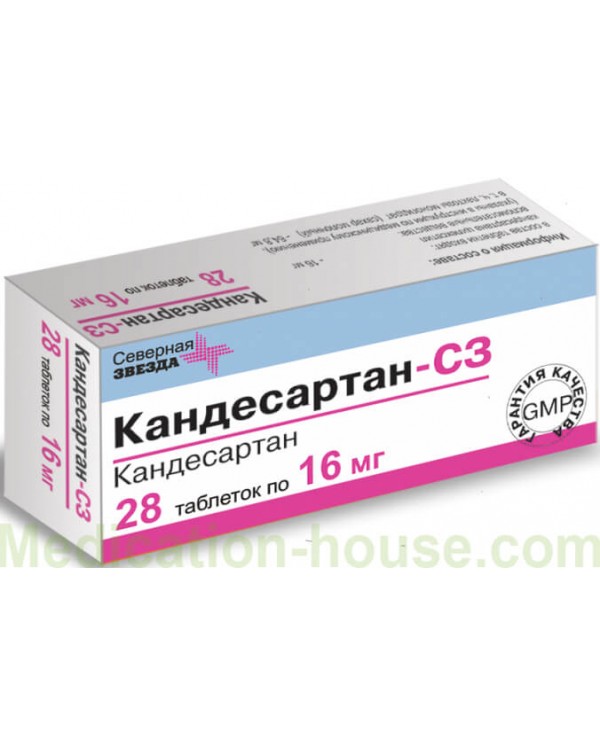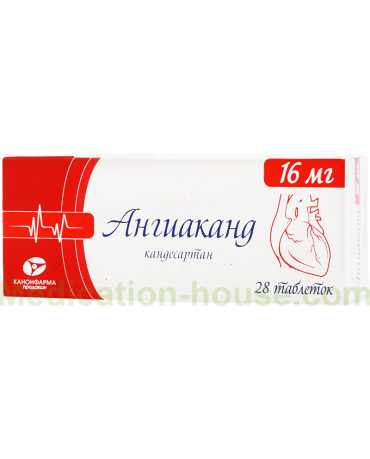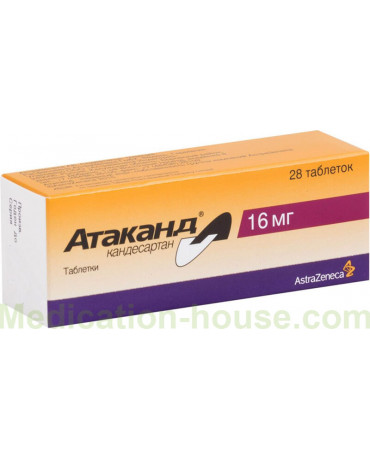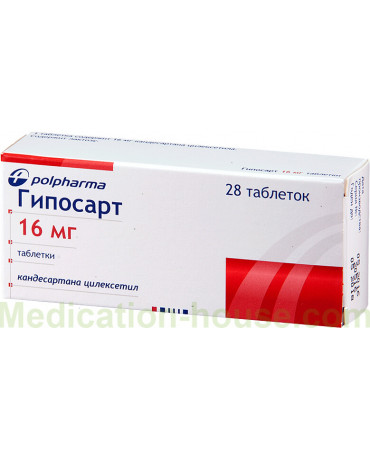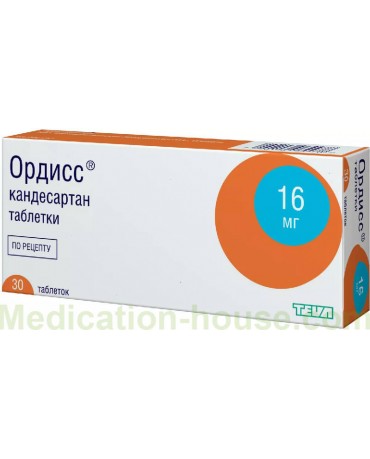Instruction for Candesartan
Reed more and buy Candesartan on this page
Candesartan is an antihypertensive drug.
Release form and composition
The drug is produced in the form of tablets: round, flat-cylindrical, almost white or white, with a chamfer and a dividing line on one side (7 pieces in blisters, in a cardboard box 2, 4 or 8 blisters; 10 pieces in blisters, in a cardboard box 3 or 6 blisters; 14 pcs. in blisters, in a cardboard box 1, 2 or 4 blisters; 28 pcs. in polymer cans, in a cardboard box 1 can. Each pack also contains instructions for the use of Candesartan).
1 tablet contains:
active substance: candesartan cilexetil - 8, 16 or 32 mg;
auxiliary components: lactose monohydrate, microcrystalline cellulose, pregelatinized starch, sodium lauryl sulfate, croscarmellose sodium, low-substituted hyprolose, magnesium stearate.
Pharmacodynamics
Candesartan is an antihypertensive drug. Its active substance is an antagonist of angiotensin II receptors - the main hormone of the RAAS (renin-angiotensin-aldosterone system), which plays an important role in the pathogenesis of arterial hypertension and cardiovascular diseases.
The mechanism of action is mediated by the interaction of angiotensin II with AT1 receptors (type 1 angiotensin receptors), the blocking of which causes a decrease in such biological effects of angiotensin II as a vasoconstrictor effect, a stimulating effect on the release of aldosterone and cell growth, regulation of salt and water homeostasis.
The antihypertensive effect is due to a decrease in OPSS (total peripheral vascular resistance) without a reflex increase in heart rate (heart rate). In case of arterial hypertension, taking the drug once a day provides a smooth dose-dependent decrease in blood pressure (blood pressure) for 24 hours, the antihypertensive effect develops within the first two hours. With regular use in a fixed dose, the maximum effect is achieved after 28 days and lasts for the entire period of treatment.
In chronic heart failure and reduced systolic function of the left ventricle [LVEF (left ventricular ejection fraction) 40% or less] contributes to a decrease in systemic vascular resistance and capillary pressure in the lungs, an increase in the concentration of angiotensin II in plasma and renin activity, a decrease in aldosterone levels.
Candesartan does not inhibit ACE (angiotensin-converting enzyme), does not bind to receptors of other hormones, does not block ion channels, which are actively involved in the regulation of the functions of the cardiovascular system.
After taking the first dose, it does not cause severe hypotension, and after stopping therapy, it does not cause withdrawal.
Pharmacokinetics
After oral administration of candesartan, cilexetil, when absorbed from the digestive tract through ether hydrolysis, quickly turns into an active substance - candesartan. Cmax (maximum concentration) in blood plasma is reached after 3-4 hours. With increasing doses in the therapeutic range (not more than 32 mg), the plasma concentration level shows a linear relationship.
Plasma protein binding - 99.8%, Vd (volume of distribution) - 0.13 l / kg.
Candesartan is metabolized in the liver slightly (up to 30%) with the participation of the CYP2C isoenzyme with the formation of an inactive metabolite.
The final half-life (T1 / 2) is 9 hours. Renal clearance is approximately 0.19 ml / min / kg, total clearance is 0.37 ml / min / kg. It is excreted through the kidneys by glomerular filtration and active tubular secretion: in the form of candesartan - 26%, in the form of an inactive metabolite - 7%. Intestinal excretion is approximately 66% of the dose taken. It does not cumulate, during the first 72 hours after a single dose, more than 90% of the dose is excreted.
In elderly patients over 65 years of age, the Cmax of candesartan increases by 50%, and the AUC (area under the concentration-time pharmacokinetic curve) by 80%, compared with younger people.
With mild and moderate renal dysfunction, Cmax rises by 50%, AUC - by 70%, T1 / 2 does not change. In severe renal failure, there is an increase in Cmax by 50%, AUC by 110%, T1 / 2 increases by 2 times.
With mild and moderate liver dysfunction, the AUC of candesartan increases by 23%.
Indications for use
arterial hypertension;
chronic heart failure and deterioration of the systolic function of the left ventricle (LVEF less than 40%) - as part of combination therapy with ACE inhibitors or with their intolerance.
Contraindications
Absolute:
severe liver dysfunction, cholestasis;
concomitant therapy with drugs containing aliskiren in patients with diabetes mellitus and / or with moderate / severe renal failure, if GFR (glomerular filtration rate) is less than 60 ml / min per 1.73 m2 of body surface;
primary lactase deficiency, lactose intolerance, glucose-galactose malabsorption;
simultaneous use with ACE inhibitors in persons with diabetic nephropathy;
pregnancy and breastfeeding;
age up to 18 years;
hypersensitivity to the components of the drug.
Candesartan should be taken with caution in case of bilateral renal artery stenosis, stenosis of the artery of a single kidney, severe renal dysfunction with CC (creatinine clearance) less than 30 ml / min, conditions after kidney transplantation, hypertrophic obstructive cardiomyopathy, cerebrovascular pathologies of ischemic origin, hemodynamic and aerobic and / or mitral valve, coronary artery disease (coronary heart disease), reduced BCC (circulating blood volume), hyperkalemia, primary hyperaldosteronism and patients on hemodialysis.
Instructions for use: method and dosage
Candesartan tablets are taken once a day, regardless of the meal.
The doctor sets the dose and therapy regimen individually, in accordance with the indications and response to therapy.
Recommended daily dosage of the drug:
arterial hypertension: initial and maintenance dose - 8 mg. The maximum antihypertensive effect is achieved within 28 days. If it is necessary to further lower blood pressure, the daily dose is increased to 16 mg. If the use of Candesartan at a dose of 16 mg for 28 days does not reduce blood pressure sufficiently, a dose of 32 mg should be prescribed. Elderly people do not need an initial dose adjustment. The initial dose for mild or moderate renal failure (CC 30–80 ml / min), including patients on hemodialysis, is 4 mg. With mild to moderate hepatic impairment, treatment should be started with a dose of 4 mg, if necessary, its increase is allowed. To enhance the antihypertensive effect and lower blood pressure to an optimal level, it is possible to co-administer Candesartan with hydrochlorothiazide or other thiazide-type diuretics. The initial dose for hypovolemia is 4 mg;
chronic heart failure: the initial dose is 4 mg. An increase to the maximum tolerated dose is carried out at intervals of at least 14 days by doubling the previous dose. In the elderly and in patients with impaired renal and / or liver function, adjustment of the initial dose is not required. Can be used in conjunction with ACE inhibitors, diuretics, beta-blockers and cardiac glycosides.
Side effects
cardiovascular system: a marked decrease in blood pressure;
nervous system: headache, dizziness, vertigo;
infections: respiratory infectious diseases;
metabolism: hyperkalemia, hyponatremia;
hematopoietic system: neutropenia, leukopenia, agranulocytosis;
digestive system: nausea, liver dysfunction, increased liver enzymes, hepatitis;
respiratory system: cough;
musculoskeletal system: back pain, arthralgia, myalgia;
immune system: rash, urticaria, angioedema;
urinary system: impaired renal function, in predisposed patients - renal failure;
dermatological reactions: pruritus;
laboratory parameters: an increase in the content of potassium, the level of creatinine and urea, a decrease in the concentration of sodium, a slight decrease in the level of hemoglobin;
general reactions: weakness.
Overdose
Symptoms of candesartan overdose: clinically significant decrease in blood pressure, dizziness.
Treatment: symptomatic therapy, patient monitoring. With severe arterial hypotension, the patient must take a horizontal position with raised legs. If necessary, the appointment of intravenous (intravenous) administration of 0.9% sodium chloride solution is indicated to increase the BCC. The hemodialysis procedure is ineffective.
Special instructions
In chronic heart failure, it is recommended to periodically monitor kidney function. It should be borne in mind that concomitant therapy with ACE inhibitors may increase the risk of side effects. It is necessary to monitor laboratory parameters and carefully monitor the condition of patients, especially aged 75 years and older, with impaired renal function and hyperkalemia. Against the background of candesartan therapy in patients with chronic heart failure, the risk of arterial hypotension increases. Particular care should be taken at the beginning of the course. If necessary, timely correct hypovolemia.
By increasing the dose of Candesartan, potassium and creatinine levels should be monitored.
In patients on hemodialysis, the dose must be titrated under close control of blood pressure.
With bilateral renal artery stenosis or stenosis of an artery of a solitary kidney, the use of angiotensin II receptor antagonists can cause an increase in the concentration of urea and creatinine in the blood serum.
During surgical interventions and general anesthesia while receiving an antihypertensive agent, patients may develop arterial hypotension. In case of severe arterial hypotension, intravenous administration of vasopressors and / or plasma replacement solutions is indicated.
When using an antihypertensive drug in patients with cerebrovascular pathologies of atherosclerotic genesis or ischemic heart disease, it should be borne in mind that a sharp decrease in blood pressure may contribute to the development of myocardial infarction or stroke.
Influence on the ability to drive vehicles and complex mechanisms
During the period of treatment with Candesartan tablets, increased fatigue and dizziness may appear. What needs to be considered when performing all activities that require concentration of attention and high speed of psychomotor reactions, including driving, and be careful.
Application during pregnancy and lactation
The appointment of Candesartan during pregnancy and breastfeeding is contraindicated.
Childhood use
The drug is contraindicated in children and adolescents under 18 years of age.
With impaired renal function
The appointment of Candesartan is contraindicated for moderate to severe renal failure (GFR less than 60 ml / min per 1.73 m2 of body surface area).
Antihypertensive treatment is carried out with caution in case of impaired renal function with CC less than 30 ml / min, primary hyperaldosteronism, bilateral renal artery stenosis or stenosis of an artery of a single kidney, a history of kidney transplantation and / or patients on hemodialysis. Requires regular monitoring of the concentration of potassium and creatinine in blood plasma in patients with renal insufficiency. When CC is less than 15 ml / min, the dose must be selected under close control of blood pressure.
For violations of liver function
The use of Candesartan is contraindicated in severe liver failure and / or cholestasis.
Use in the elderly
It is recommended to take the drug with caution in elderly patients due to the existing risk of worsening the course of concomitant diseases. Periodic monitoring of renal function is necessary, especially in patients aged 75 years and older.
Drug interactions
ACE inhibitors: concomitant therapy with ACE inhibitors can lead to increased hypotension, hyperkalemia, impaired renal function (including patients with diabetic nephropathy), so it is recommended to avoid such combinations;
aliskiren, aliskiren-containing drugs: the combination of the drug cilexetil with aliskiren causes a double blockade of the RAAS and increases the risk of arterial hypotension, changes in renal function, hyperkalemia;
antihypertensive drugs: enhance the antihypertensive effect;
potassium-sparing diuretics, potassium preparations, potassium salt substitutes, containing potassium biologically active food supplements: a combination with each of these agents can lead to the development of hyperkalemia;
lithium preparations: the level of lithium in the blood serum and the risk of its toxic reactions increase;
diuretics: increase the risk of arterial hypotension;
selective inhibitors of cyclooxygenase-2, acetylsalicylic acid (in a daily dose of more than 3 g) and other non-steroidal anti-inflammatory drugs: the combined use of these drugs can lead to a decrease in the antihypertensive effect of candesartan, an increase in the concentration of potassium in the blood serum and the risk of impaired renal function (including the development of acute renal failure). During the period of combination therapy, it is necessary to maintain sufficient BCC, replenishing fluid loss, and carefully monitor renal function.
Terms and conditions of storage
Keep out of the reach of children.
Store in manufacturer's packaging at temperatures up to 25 ° C.
The shelf life is 3 years.
Reviews
Patient reviews of Candesartan are often positive. In primary hypertension, it regulates and lowers blood pressure well. For some hypertensive patients, it is enough to drink half a tablet a day. Attractive is the low cost, the possibility of selecting a dose from 4 to 32 mg, a convenient regimen of administration - once a day, keeps blood pressure well.
Experts say that the drug is effective both in monotherapy and in combination treatment, has a long-term hypotensive effect - up to 36 hours, practically does not cause side effects.
Terms of sell
You don't need a prescription to buy Candesartan.

